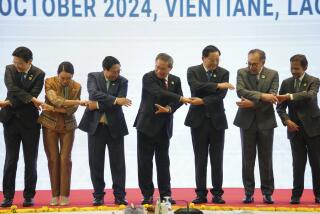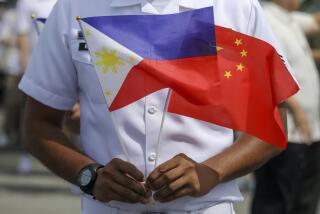Southeast Asian nations give weak rebuke to China over South China Sea dispute
Reporting from VIENTIANE, Laos — China scored an unequivocal diplomatic victory Monday, preventing Southeast Asia’s main grouping from criticizing it for territorially expanding in the South China Sea, even though some of the bloc’s members are victims of Beijing’s actions.
After hectic negotiations, the 10 members of the Assn. of Southeast Asian Nations issued a watered-down rebuke that amounted to less than a slap on the wrist, and exposed the deep divisions in a regional body that prides itself on unity.
In a joint communique released after their talks, the foreign ministers of ASEAN said only that they “remain seriously concerned over recent and ongoing developments” in the South China Sea. The statement did not mention China by name in referring to the developments.
Most significantly, it failed to mention a recent ruling by an international arbitration panel in a dispute between the Philippines and China that said Beijing’s claims in the South China Sea were illegal and that the Philippines was justifiably the aggrieved party. China has dismissed the ruling as bogus, saying the Hague-based tribunal has no authority to rule on what Beijing calls bilateral disputes. China wants direct negotiations with the Philippines instead.
The tribunal’s award “amounts to prescribing a dose of wrong medicine ... and it seems that certain countries outside the region have got all worked up, keeping the fever high,” Chinese Foreign Minister Wang Yi said, referring to the United States. “And if the prescription is wrong it will not help cure any disease. That’s why we urge other countries in the region to lower the temperature,” he told a news conference after 90 minutes of talks with the ASEAN ministers.
Wang said about 80% of that time was spent on ASEAN-China relations, and only 20% on South China Sea. He joked that reporters had expended more than 80% of the question-and-answer time on the South China Sea.
“Both China and ASEAN believe this page should have been turned and temperature lowered,” he said.
China was able to push through its stance in ASEAN with the help of Cambodia, and to some extent Laos, both of which are close friends of Beijing. ASEAN’s guiding principle is to make all statements by consensus, so a veto by Cambodia would have prevented a more stinging rebuke.
“We reaffirmed the importance of maintaining and promoting peace, security, stability, safety and freedom of navigation in and over-flight above the South China Sea,” the joint statement said.
“We further reaffirmed the need to enhance mutual trust and confidence, exercise self-restraint in the conduct of activities and avoid actions that may further complicate the situation,” it said.
Such statements have previously been issued, notably after an ASEAN-U.S. summit in California in February, and have led to criticism that ASEAN is becoming a toothless organization.
Analysts say this amounted to another capitulation by ASEAN in the face of China’s power.
“ASEAN’s failure to mention the tribunal’s decision will not affect the implementation of the ruling per se, as China has already indicated that it won’t recognize or accept it. But failure to even mention the landmark legal ruling once again highlights ASEAN’s inability to present a united front and China’s skill at using Cambodia as a proxy to further its own interests,” said Ian Ward, a senior fellow at Singapore’s Institute of Southeast Asian Studies think tank.
The South China Sea is dotted with reefs and rocky outcroppings that several governments claim, including China and the Philippines. The arbitration panel didn’t take a position on who owns the disputed territories. It did conclude that many of them are legally rocks, even if they’ve been built into islands, and therefore do not include the international rights to develop the surrounding waters. That and other findings invalidated much of what China has called its historic claims to the resource-rich sea.
In order to ease tensions, China, the Philippines and possibly other claimants must define what the ruling means for fishing, offshore oil and gas exploration, and military and other activities in the vast body of water that lies between the southern Chinese coast and the Philippine archipelago.
In recent days, China’s military has staged live-firing exercises in the area and said it would begin regular aerial patrols over the sea. It also has asserted that it will not be deterred from continuing construction of its man-made islands.
On Sunday, Wang, the Chinese foreign minister, reiterated his government’s position that it will accept only bilateral negotiations with the Philippines.
“Every country has the same position as China, that is that we should fully and effectively implement the regional Code of Conduct, and in that COC it clearly states the dispute should be resolved by peaceful, sit-down talks between the parties directly concerned,” he said.
He was scheduled to give a news conference later Monday after his talks with ASEAN ministers.
UPDATES:
July 25, 5:06 a.m.: Updates throughout.
This story was originally posted July 24 at 11:10 p.m.
More to Read
Sign up for Essential California
The most important California stories and recommendations in your inbox every morning.
You may occasionally receive promotional content from the Los Angeles Times.










